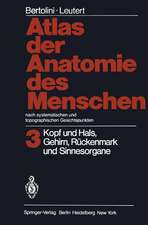Maturation Phenomenon in Cerebral Ischemia III: Defensive Mechanisms Versus Apoptosis Neuronal Recovery and Protection in Cerebral Infarction
Editat de Umeo Ito, Cesare Fieschi, Francesco Orzi, Toshihiko Kuroiwa, Igor Klatzoen Limba Engleză Paperback – 24 mar 1999
Preț: 719.59 lei
Preț vechi: 757.46 lei
-5% Nou
Puncte Express: 1079
Preț estimativ în valută:
137.71€ • 143.24$ • 113.69£
137.71€ • 143.24$ • 113.69£
Carte tipărită la comandă
Livrare economică 14-28 aprilie
Preluare comenzi: 021 569.72.76
Specificații
ISBN-13: 9783540650232
ISBN-10: 3540650237
Pagini: 368
Ilustrații: XVIII, 343 p. 68 illus., 15 illus. in color.
Dimensiuni: 155 x 235 x 19 mm
Greutate: 0.51 kg
Editura: Springer Berlin, Heidelberg
Colecția Springer
Locul publicării:Berlin, Heidelberg, Germany
ISBN-10: 3540650237
Pagini: 368
Ilustrații: XVIII, 343 p. 68 illus., 15 illus. in color.
Dimensiuni: 155 x 235 x 19 mm
Greutate: 0.51 kg
Editura: Springer Berlin, Heidelberg
Colecția Springer
Locul publicării:Berlin, Heidelberg, Germany
Public țintă
Professional/practitionerDescriere
The Maturation Phenomenon, described by Ito et al. in 1975 [3) on the basis of his to logical observations in the hippocampus as well as other portions of the cerebral hemisphere, refers to the hours or days of delay in the development of pathological changes in various parameters of ischemic injury following the restoration of blood flow to the ischemic brain. There is a direct relationship between the intensity of ischemic insult and the speed and rate of maturation of ischemic injury, a lesser intensity being associated with slower and less severe development of the lesions. The delayed neuronal death of CAl pyramidal cells of the hippocampus [8) is a classic example. In the cerebral cortex, with increasing intensity of the ischemic insult, the maturation phenomenon of ischemic injuries intensifies, seamlessly, from less exten sive to more extensive disseminated selective neuronal necrosis (DSNN), and then further to cerebral infarction upon reaching a critical threshold [1,2,4,6,7). We also have found that following ischemic insults just under the threshold level required to induce infarction, only disseminated selective neuronal necrosis (DSNN) progresses, while following ischemic insults at the threshold level, initially only DSNN develops, followed by the evolution of a gradually enlarging infarcted focus [5, 7). The reporting of this phenomenon boosted research in the field, as it became evi dent that ischemic damage is not a sudden event, but a process potentially susceptible to therapeutic intervention.
Cuprins
I Role of Genetic Expression and Neuronal Apoptosis and/or Necrosis.- Multiple Molecular Penumbras Associated with Focal Ischemia in Brain.- Aspects of Maturation Phenomenon Observed by the TUNEL Method.- Delayed Gene Expression and Ischemic Brain Injury.- The Role of Programmed Cell Death in Cerebral Ischemia.- The Role of Caspase-3 Like Protease in the Hippocampus After Transient Global Ischemia.- Alterations in Translation Initiation Following Global Brain Ischemia.- Studies of Neuronal Necrosis and Apoptosis after Global Cerebral Ischemia in Superoxide Dismutase Transgenic and Knockout Mutants.- Apoptosis-Related Genes Are Expressed in the Rat Model of Subarachnoid Hemorrhage.- No Morphological Evidence of Apoptosis Following Mild to Severe Episodes of Four-Vessel-Occlusion Ischemia in Rats.- II Factors and Mechanisms Enhancing Susceptibility or Tolerance (Growth Factors).- Stimulation of ?2-Adrenoceptors Induces Nerve Growth Factor and Inhibits Apoptosis in Rat Brain After Ischemia.- Ischemia-Induced Dynamic Cellular Response in the Brain.- Oxygen Free Radicals and Ischaemic Preconditioning in the Brain: Preliminary Data and a Hypothesis.- Ischemic Tolerance in the Maturation of Disseminated Selective Neuronal Necrosis and Cerebral Infarction After Repetitive Ischemia.- Upregulation of Vascular Endothelial Growth Factor Protein Levels in Global Ischemia Induced by Cardiac Arrest and Resuscitation in Rat Brain.- Neuroprotective Effect of Hepatocyte Growth Factor.- III Factors Modulating Neuronal Plasticity and the Course of Maturation Phenomenon in Cerebral Ischemia (Metabolic and Inflammatory Factors).- Tumor Necrosis Factor-?-Induced Ischemic Tolerance as Manifested by Microvascular and Endothelial Cell Responses.- The Role of Glial and Inflammatory Reactions in Cerebral Ischemia.- Effect of EndothelinA Receptor Antagonist on Neuronal Injury in Global and Focal Ischemia.- Lowering of Ameboid Microglial Resistance to Hydrogen Peroxide by Propentofylline.- Combination Therapy: A Promising Treatment Strategy for Cerebral Ischemia.- Another Facet of Nitric Oxide: Reduction of Toxis Zinc Influx Through Voltage-Gated Channels.- Slowly Progressive Neuronal Degeneration in Remote Areas After Focal Cerebral Ischemia.- Metabolic Disturbance and Gene Responses Following Cortical Injury in Rats: Relationship to Spreading Depression.- Protein Expression and Brain Plasticity After Transient Middle Cerebral Artery Occlusion in the Rat.- Alteration of Cyclic Adenosine Monophosphate Binding in Ischemic Brain: Sensitive Metabolic Marker for Early Ischemit Tissue Damage.- IV Ischemic Infarction: Threshold, Experimental and Clinical Dynamics and Therapeutic Design for Prevention or Reduction of Intensity.- Role of Mitochondria in Immediate and Delayed Reperfusion Damage.- Temporal Profile of Cortical Injury Following Ischemic Insult Just Below and at the Threshold Level for Induction of Infarction — Light and Electron Microscopic Study.- Mitochondrial Dysfunction and Maturation Phenomenon in Ischemic Gerbil Cortex.- Metabolic Ca2+ Signalling and Refilling of Ca2+ Stores in Hippocampal Astrocytes Are Driven by Adenosine Triphosphate Supplied by Glycolysis.- Brain-Derived Neurotrophic Factor and Ciliary Neurotrophic Factor Treatment of Focal Cerebral Ischemia in Rat.- Environmental Influence on Neurotrophic Gene Expression After Experimental Brain Infarction in the Rat.- Delayed Neuronal Death in Experimental Ischemic Stroke.- A Rat Model to Study Damage and Defense Mechanisms Under Penumbra Conditions.- Instrumental Diagnosis and Treatment of Acute Ischemic Stroke: The Clinician’s Perspective.- V Special Lecture.- Mechanisms of Regulation of Cerebral Blood Flow.- VI Poster Presentations (Abstracts).- The Protective Effect of DY9760e, a Novel Calmodulin Antagonist, on Rat Permanent Middle Cerebral Artery Occlusion.- Amelioration of Brain Damage Following Transient Focal Ischemia in Rats by ONO-2506: Relevance of Its Modulating Action on Astroglial Functions.- The Effect of ONO-2506 on Permanent Focal Ischemia in Rats.- Preconditioning with 5 Min Forebrain Ischemia Ameliorated Mortality and Brain Edema Caused by 15 Min Forebrain Ischemia in the Gerbil.- Alteration of Control Mechanisms of Endoplasmic Reticulum Calcium Pools in Focal Cerebral Ischemia.- Global Ischemia Induces Downregulation of G1uR2 mRNA and Increases AMPA Receptor-Mediated Ca2+ Influx in Hippocampal CA1 Neurons.- SPD 502 (NS 1209), a New Selective AMPA Antagonist, Reduces the Infarct Size in Rats Following Permanent Occlusion of the Middle Cerebral Artery.- Neuroprotective Effects of Magnesium and Tirilazad in Rats Subjected to Transient Focal Cerebral Ischemia.- Do Natural Antioxidants Protect Neurons from Oxidative Stress Due to Their Anti-Radical Activity?.- Carnosine Prevents Neurons from Excitoxic Effects of NMDA and Kainate.- Aspects of Tolerance and Apoptosis: Cell and Molecular Biological Studies.- VII Round Table Discussion.- Round Table Summary.
Textul de pe ultima copertă
The maturation phenomenon refers to postischemic changes that develop hours or days following an ischemic insult. The delayed neuronal death of CA1 pyramidical cells of the hippocampus is a classic example. The report of the phenomenon has boosted research in this field, as it became evident that ischemic damage is not a sudden event but a process potentially susceptible to therapeutic intervention. In September 1990, the first international symposium on "Maturation Phenomenon in Cerebral Ischemia" was held in Tokyo. The second symposium was organized in Tokyo in March/April 1996. Since then, new developments have rapidly delivered information about the molecular nature and dynamics of mechanisms concerning cell death and recovery. This book contains the presentations of the 3rd international symposium held in Pozilly/Italy in April 1998. It outlines the present status of the investigation and provides further stimulation for research in this field.





